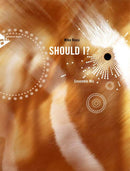| 作曲者 | Mike Svoboda |
| タイトル | Should I? |
| 出版社 | advance music GmbH |
| 楽器編成 | 3 melody instruments, rhythm section |
| 楽器編成(詳細) | Part 1: Flute, Oboe, Violin, Guitar (C), Alto Sax (Eb), Trumpet, Clarinet, Soprano- & Tenor Sax (Bb), Part 2: Alto Sax (Eb), Trumpet, Clarinet, Tenor Sax (Bb), 3: Trombone (C), Baritone Sax (Eb), Tenor Sax (Bb), Rhythm Section |
| 品番 | 9790206304972 |
| 難易度 | 上中級 |
| 形状 | 44 ページ・Folder |
| 出版年 | 2010年 |
| 出版番号 | ADV 17055 |
| ISMN | 9790206304972 |
| ISBN | 9783892213727 |
This piece originated from my days in Boston in the mid-1980s as a graduate student and as part of the New England Conservatory Honors Jazz Ensemble, which performed music from across many wide ranging styles. Good interaction amongst the rhythm section is crucial. If you have a guitarist or electric keyboard/s in the rhythm section, feel free to incorporate a range of electronic effects in order to change textures. Changes in dynamics within the rhythm section is of prime importance. Think of music from the Miles Davis groups and albums of the late 1960s and early 70s such as In a Silent Way, Bitches Brew, and On the Corner. This Jazz-Rock piece has plenty of room to stretch out over the two key centers of A7 (alt) and Eb minor. The melody should be played with a straight eighth-note feel with attention to the accented (>) and capped (^) notes at Letters A and C. Watch the change in dynamics starting one beat before Letter D until the end of the form. At Letters B, F, F1 (the bridge of the form), the rhythm section shifts to a 12/8 African feel. The interlude at Letter I happens only at the end of each solo form. Note - The solo/ensemble interlude at Letter E1 follows a 16, 10 (8+2), 16 bar form which is different than the solo form at E-H. The interlude at Letter E1 was written to assist soloists with material to play or draw from during solos. Should I? can be heard on Beauty and the Blues (MMC2045J) with jazz greats Billy Hart, Rufus Reid and Tom McKinley.



